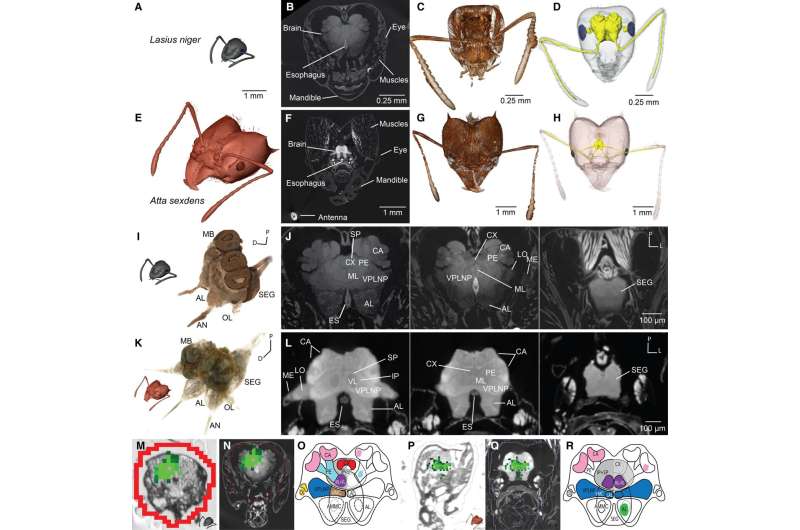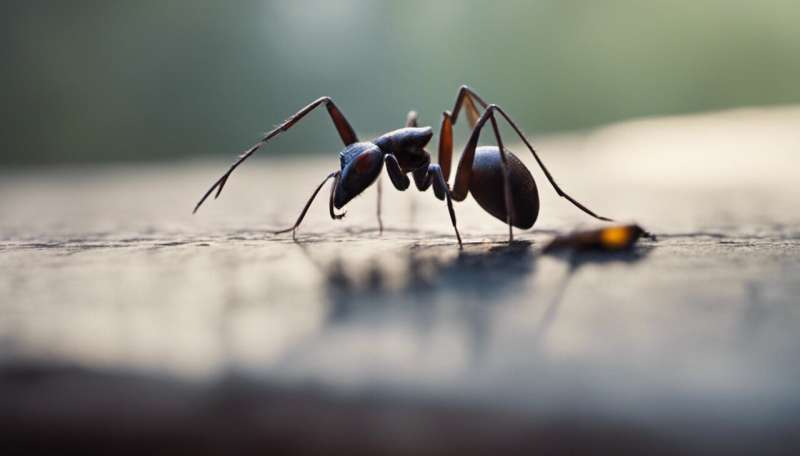This article has been reviewed according to Science X's editorial process and policies. Editors have highlighted the following attributes while ensuring the content's credibility:
fact-checked
peer-reviewed publication
trusted source
proofread
New insights into the complex neurochemistry of ants

Ants' brains are amazingly sophisticated organs that enable them to coordinate complex behavior patterns such as the organization of colonies. Now, a group of researchers led by Christian Gruber of MedUni Vienna's Institute of Pharmacology have developed a method that allows them to study ants' brain chemistry and gain insights into the insects' neurobiological processes. The findings could help to explain the evolution of social behavior in the animal kingdom, and shed light on the biochemistry of certain hormone systems that have developed similarly in both ants and humans.
For the study, the researchers used a combination of high-resolution mass spectrometry imaging (MSI) and micro-computed tomography (µCT) to map the three-dimensional distribution of neuropeptides in the brains of two ant species: the leafcutter ant (Atta sexdens) and the black garden ant (Lasius niger).
Researchers from MedUni Vienna, the Max Planck Institute for Marine Microbiology in Bremen and the University of Bremen have developed the new method for studying social insects' brains, which measure only a few millimeters in size. In future, their approach could play a decisive role in research into fundamental neurobiological processes. The method integrates three-dimensional chemical data into a high-definition anatomical model, allowing for unbiased visualization of 3D neurochemistry in its particular anatomical environment.
Published in the journal PNAS Nexus, the study showed that some ant peptides, such as the tachykinin-related peptides TK1 and TK4, are widely distributed in many areas of both species' brains, while other peptides, including myosuppressin, are only found in particular regions. The researchers also noticed differences between the two species—a large number of peptides were found in the optic lobe of L. niger, but only one (an ITG-like peptide) was identified in the same region in A. sexdens.

The key feature of the new method is that a correlative approach is used to analyze data. This means that 3D maps of the distribution of neuropeptides and 3D anatomical models are precisely collated, generating two maps that help to navigate the ants' brains.
Each map contains different information, which is critical for studying organs with high plasticity, such as the brains of social insects, which are particularly hard to analyze due to the complex division of labor and caste system in ant colonies. Building on previous studies of MS imaging of neuropeptides in invertebrate model systems, this approach represents a promising method for studying fundamental neurobiological processes by visualizing distortion-free 3D neurochemistry in its own complex anatomical environment.
"These findings have the potential to fundamentally alter the way we study complex neurobiological processes. Our method opens up new perspectives when it comes to observing the brains of social insects more closely and better understanding the functioning of nervous systems where chemistry and anatomy are fully attuned," commented lead author Benedikt Geier, who worked alongside co-lead author Esther Gil Mansilla.
"In terms of neurobiology, ants are a model species. Due to the extremely complex structures in ant colonies, this method could be applied in future to gain an understanding of various factors, including the evolution of social behavior in the animal kingdom, or the biochemistry of certain hormone systems that have developed in a similar fashion in both ants and humans," reported Christian Gruber.
More information: Benedikt Geier et al, Multiplexed neuropeptide mapping in ant brains integrating microtomography and three-dimensional mass spectrometry imaging, PNAS Nexus (2023). DOI: 10.1093/pnasnexus/pgad144
Journal information: PNAS Nexus
Provided by Medical University of Vienna





















